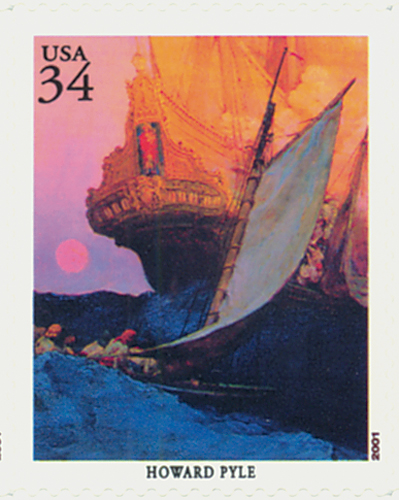
# 3502h - 2001 34c American Illustrator Howard Pyle
Howard Pyle
34¢ American Illustrators
City: New York, NY
Quantity: 125,000,000
Printed by: Avery Dennison Security Printing
Printing Method: Photogravure
Perforations: Serpentine die cut 11.25
Color: Multicolored
Birth Of Howard Pyle
Pyle had an interest in drawing and writing from a very young age. He attended private schools but had little interest in academics. Luckily, his parents encouraged his creativity and his desire to study art.
The majority of Pyle’s art education took place over three years in Philadelphia under F.A. Van der Weilen, though he also took a few lessons at the Art Students League of New York. In 1876, Pyle visited Chincoteague Island, off the coast of Virginia and was so inspired, he illustrated what he saw and wrote an article about it. Pyle submitted it to Scribner’s Magazine, making it his first published illustration. The magazine’s owner recognized Pyle’s talent and suggested he go to New York to find work as a professional illustrator.
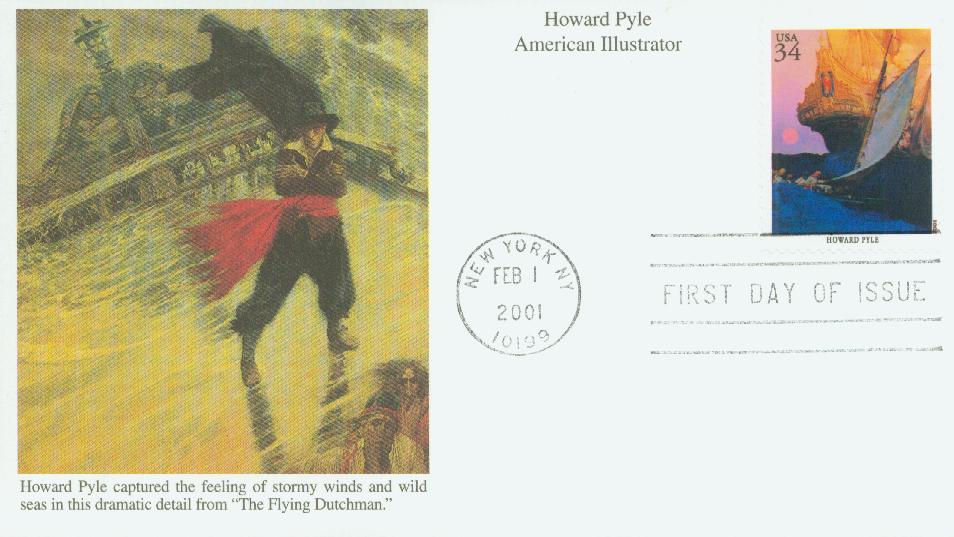
Pyle initially struggled to find work in New York, but in 1878, he illustrated a two-page spread in Harper’s Weekly and was paid five times what he expected. From there, Pyle grew more confident and got more jobs. He returned to Wilmington in 1880 and continued to illustrate for magazines such as Century, Everybody’s, Harper’s, Ladies Home Journal, St. Nicholas, and Collier’s.
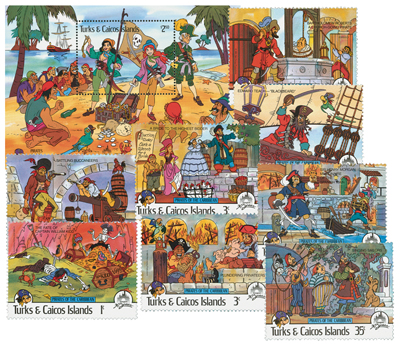
In 1883, Pyle wrote and illustrated his first book, The Merry Adventures of Robin Hood. Over the years, he would write and illustrate several more books, including Men of Iron and The Story of King Arthur and his Knights. About half of the 3,300 illustrations he published during his lifetime were for his own stories and books. Pyle’s images were accurately and skillfully executed and were distinctive for their drama and excitement. He had a particular interest in pirates and is often credited with creating the modern image of flamboyantly-dressed pirates. This image was further popularized in the movies of Errol Flynn and even today’s Pirates of the Caribbean films.
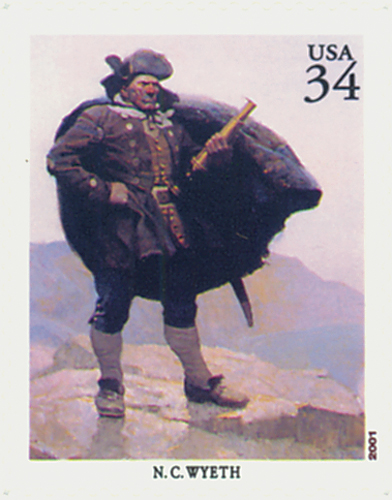
In 1894, Pyle began teaching at the Drexel Institute. He remained there until 1900 when he created his own art school in Wilmington. As a teacher, Pyle had far-ranging influence. Over one hundred carefully selected students studied under him, tuition-free, in Wilmington and Chadds Ford, Pennsylvania. This “Brandywine School” included N.C. Wyeth, Harvey Dunn, Maxfield Parrish, and Jessie Willcox Smith. “Throw your heart into your pictures and leap in after it,” Pyle told his students, “…feel the wind and rain on your skin when you paint it.”
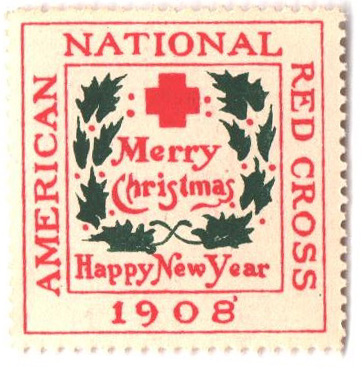
In 1903, Pyle began painting murals for the Delaware Art Museum. Three years later, he painted the Battle of Nashville in the Minnesota state capitol. He also painted two murals in New Jersey courthouses. In 1908, fellow Wilmington native Emily Bissell asked Pyle to design the first nationally distributed Christmas seal.
In 1910, Pyle took his family to Italy so he could study the old masters. However, his health declined quickly and he died after just a year there, on November 9, 1911.
Howard Pyle
34¢ American Illustrators
City: New York, NY
Quantity: 125,000,000
Printed by: Avery Dennison Security Printing
Printing Method: Photogravure
Perforations: Serpentine die cut 11.25
Color: Multicolored
Birth Of Howard Pyle
Pyle had an interest in drawing and writing from a very young age. He attended private schools but had little interest in academics. Luckily, his parents encouraged his creativity and his desire to study art.
The majority of Pyle’s art education took place over three years in Philadelphia under F.A. Van der Weilen, though he also took a few lessons at the Art Students League of New York. In 1876, Pyle visited Chincoteague Island, off the coast of Virginia and was so inspired, he illustrated what he saw and wrote an article about it. Pyle submitted it to Scribner’s Magazine, making it his first published illustration. The magazine’s owner recognized Pyle’s talent and suggested he go to New York to find work as a professional illustrator.

Pyle initially struggled to find work in New York, but in 1878, he illustrated a two-page spread in Harper’s Weekly and was paid five times what he expected. From there, Pyle grew more confident and got more jobs. He returned to Wilmington in 1880 and continued to illustrate for magazines such as Century, Everybody’s, Harper’s, Ladies Home Journal, St. Nicholas, and Collier’s.

In 1883, Pyle wrote and illustrated his first book, The Merry Adventures of Robin Hood. Over the years, he would write and illustrate several more books, including Men of Iron and The Story of King Arthur and his Knights. About half of the 3,300 illustrations he published during his lifetime were for his own stories and books. Pyle’s images were accurately and skillfully executed and were distinctive for their drama and excitement. He had a particular interest in pirates and is often credited with creating the modern image of flamboyantly-dressed pirates. This image was further popularized in the movies of Errol Flynn and even today’s Pirates of the Caribbean films.

In 1894, Pyle began teaching at the Drexel Institute. He remained there until 1900 when he created his own art school in Wilmington. As a teacher, Pyle had far-ranging influence. Over one hundred carefully selected students studied under him, tuition-free, in Wilmington and Chadds Ford, Pennsylvania. This “Brandywine School” included N.C. Wyeth, Harvey Dunn, Maxfield Parrish, and Jessie Willcox Smith. “Throw your heart into your pictures and leap in after it,” Pyle told his students, “…feel the wind and rain on your skin when you paint it.”

In 1903, Pyle began painting murals for the Delaware Art Museum. Three years later, he painted the Battle of Nashville in the Minnesota state capitol. He also painted two murals in New Jersey courthouses. In 1908, fellow Wilmington native Emily Bissell asked Pyle to design the first nationally distributed Christmas seal.
In 1910, Pyle took his family to Italy so he could study the old masters. However, his health declined quickly and he died after just a year there, on November 9, 1911.





